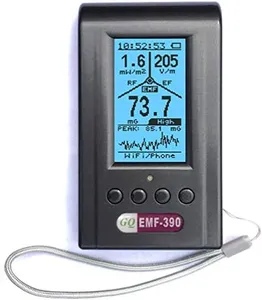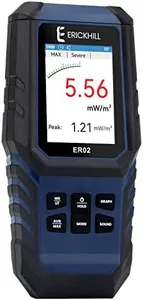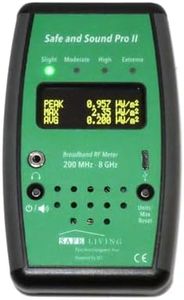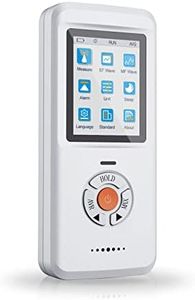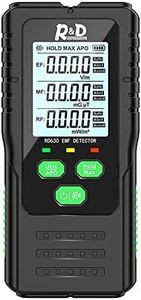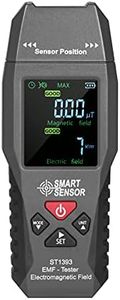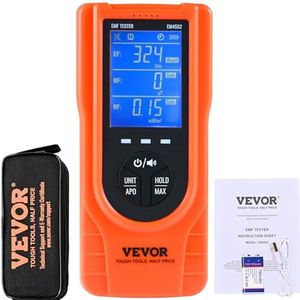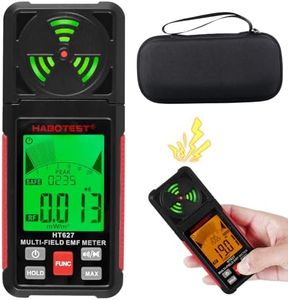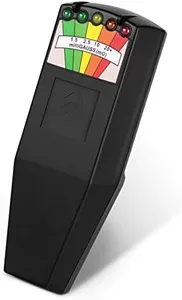We Use CookiesWe use cookies to enhance the security, performance,
functionality and for analytical and promotional activities. By continuing to browse this site you
are agreeing to our privacy policy
10 Best Emf Testers
From leading brands and best sellers available on the web.By clicking on a link to a third party's website, log data is shared with that third party.
Buying Guide for the Best Emf Testers
Choosing an EMF tester can feel a bit overwhelming at first, but when broken down into core features, it becomes much easier. EMF testers are designed to measure electromagnetic fields in your environment, which can help identify sources of exposure from things like household wiring, electronics, and other electrical devices. Your goal is to match the tester’s capabilities with your specific concerns—such as finding hotspots in your home or testing electronics—so understanding the key specifications will help you make a smart, informed choice.Measurement RangeMeasurement range refers to the span of electromagnetic field strengths the tester can detect, often measured in units like milligauss (mG) for magnetic fields or volts per meter (V/m) for electric fields. The importance of this is that different sources emit at different strengths. Basic testers may only sense higher levels, which may be suitable if you're only tracking major sources like large appliances or power lines. More advanced testers capture much lower readings, which might benefit you if you're sensitive to EMF or want to pinpoint subtle leaks from electronics. Your choice should reflect whether you need to detect only prominent EMF sources or monitor very low-level exposure.
Frequency RangeFrequency range is the spectrum of electromagnetic frequencies the tester can measure. Some testers only check low-frequency fields (like those from household wiring), while others can also detect higher frequencies, such as EMF from Wi-Fi and cell phones. A narrower frequency range is sufficient if your concern is wiring or appliances, but you’ll need a wider range if you want to include wireless devices or radio frequency sources. Decide based on the types of EMF sources you want to investigate in your space.
Axes of MeasurementAxes of measurement describes whether the EMF tester checks in a single plane (single-axis) or in all directions (three-axis/triaxial). Single-axis testers need to be rotated during use to find the highest reading, which takes a bit more effort and skill. Three-axis testers take readings in all directions at once, making them quicker and simpler—especially for beginners. If you want fast and easy readings, or aren’t sure how to manually scan, three-axis is typically more user-friendly.
Display and ReadoutThe display and readout determines how clearly the tester presents its results. Basic units may use analog dials or lights, while more advanced ones have digital screens that show precise values, sometimes with data logging. A clear digital readout is helpful if you need to track changes over time, compare rooms, or share results with someone else. If you want straightforward, easy-to-understand information, go for models with a clear, bright display and simple controls.
Detection TypesDetection types refer to whether the tester can sense just magnetic fields, only electric fields, or radio frequencies, or any combination of these. Some testers are specialized for only one type, which may be enough if you have a specific concern. Others are all-in-one, so you can use them to check various EMF sources around your home. If you’re not sure which type of EMF is most relevant to you, a multi-type tester covers more ground and is often more versatile.
Sensitivity and AccuracySensitivity and accuracy relate to how well the tester detects weak fields and how close its readings are to the real value. Higher sensitivity will pick up lower levels of EMF, which is important if you are concerned about subtle sources. Greater accuracy means you can trust the number you see on screen. For general awareness, average sensitivity and accuracy will do. If you have health concerns or need to document readings, prioritize high-sensitivity and high-accuracy instruments.
Ease of Use and ConstructionEase of use and construction includes factors like size, button layout, weight, and durability. A simple, intuitive interface with clear instructions is important if you’re not experienced. A sturdy construction is useful if you plan to carry the device around or occasionally drop it. Consider your comfort with technology and whether you’ll need to use the tester frequently or in different environments, and look for a model that feels manageable and robust for your needs.
